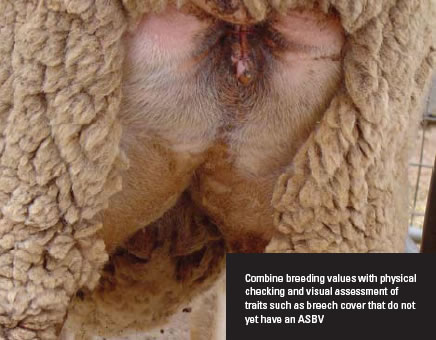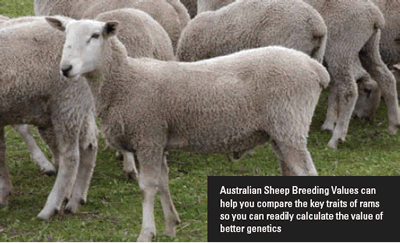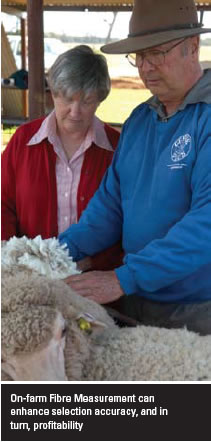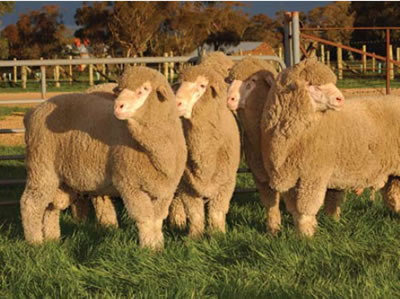 |
 |
Set breeding goals based on an assessment of future market requirement
|
 |
Use Australian sheep breeding values and visual assessment to select rams
|
 |
Seek professional advice to fine-tune the genetics in your breeding program |
|
 |
Introduction
Breeding values
The performance of a ram (body weight, fleece weight, fibre diameter, carcase quality, daughters’ maternal characteristics), is a reflection of the genes and rearing/growing environment.
This is often expressed as:
Performance = Genes + Environment (P = G+E)
Breeding values take account of the known environmental influences such as birth and rearing type, age, age of dam and management group that can significantly influence an animal’s measured performance. Breeding values also take account of management differences between flocks and groups within flocks.
The use of breeding values can greatly improve ram selection. As an example, lambs born and reared as twins have, on average, lower fleece weight, higher fibre diameter and lower body weight when compared to singles. For ram selection, these are not genetic differences that will be passed to their progeny in your flock.
Similarly, visual assessment of hoggets favours early-born single lambs from mature ewes over twin born and reared lambs, or lambs born to maiden ewes.
Two forms of breeding values are available to assist in gaining from genetics. These are the Australian Sheep Breeding Values (ASBV) that enable genetic comparisons across flocks within a breed and across flocks across breeds in the terminal sire breeds group and the Flock Breeding Values that enable genetic comparisons of sheep only within a flock (see tool 9.4).
Interpreting ASBVs
The most useful tool to interpret an ASBV, and where it ranks an animal compared with all other genetically evaluated animals, is the percentile band table. The percentile band table (see tool 9.5 for an example) shows the range in ASBVs for each trait and breaks that variation into 5% steps. It can be used to benchmark both ASBVs and indexes.
As percentile band tables change over time, source a current version from your ram supplier or the Sheep Genetics website at: www.sheepgenetics.org.au. Select either the LAMBPLAN or MERINOSELECT menu options and look for percentile bands.
Tool 9.6 provides an interpretation of the key terminal, maternal and Merino breeding values or refer to the Sheep Genetics website: http://www.sheepgenetics.org.au and look for ASBVs and Indexes explained under the Getting Started tab.

Key decisions, critical actions and benchmarks
Selecting rams with breeding values
Sheep Genetics calculates breeding values for all sectors of the sheep industry, for many traits of economic importance (see tool 9.3 for definitions). When buying rams from ram breeders who provide ASBVs, it is important to compare the average values for your current rams with your breeding targets. A useful rule of thumb for converting ram ASBVs into sheep and wool production differences is to simply halve the ASBV (because rams contribute half the genes of the lamb).
Before buying rams, sheep producers may like to benchmark the ram breeder’s ASBVs and index values so they can make their selection relative to the breeding objective for their flock. Ask your ram source for the average ASBVs and indexes of their latest lamb drop.
This information can be used as a benchmark to make effective genetic progress toward the breeding objective.
It is best practice to combine breeding values with physical checking and visual assessment of those traits that do not have an ASBV, such as soundness traits, wool character and fleece rot.
Research has been completed allowing visually assessed traits to be scored and reported as breeding values in the same way as measured traits. Traits such as wool colour and character, and conformation traits such as body development and face cover, can now be scored and reported to Sheep Genetics to obtain breeding values. ASBVs for breech wrinkle, breech cover and dag score have been released to assist in selecting sheep with a lower chance of breech flystrike. See the signposts for tools to help you visually score these traits.
Use of genetic indexes

Breeding values can be used directly in ram selection when you know the traits needed in your enterprise. Breeding values are calculated for many traits and Sheep Genetics combines these values to calculate a small number of genetic indexes. The role of these indexes is to identify sheep that best suit a general breeding direction.
Before using a genetic index, know what traits it contains and their weighting, to ensure the index suits your breeding program. When assessing high-index rams make sure that no single trait’s breeding value is dominating the index value, or the desired balance may not be achieved.
Use tool 9.7 to obtain Sheep Genetics indexes and details of the emphasis placed on the various traits or go to the Sheep Genetics web site and click on LAMBPLAN or MERINOSELECT.
Sire evaluation sites independently do progeny tests on high performing industry sires. Progeny are evaluated for both measured and visually assessed traits and reported firstly at the site and then in a combined site report called ‘Merino Superior Sires’ http://www.merinosuperiorsires.com.au/. The ASBVs reported in Merino Superior Sires can be directly compared with MERINOSELECT ASBVs. Merino Superior Sires reports on rams from many flocks that are not currently clients of Sheep Genetics flocks. Because of its comprehensive list of traits and the additional sires included, Merino Superior Sires can be of value when considering rams to use in an artificial insemination program.
Comparing rams with different breeding values

By comparing the ASBVs of rams on offer for key traits, you can readily calculate the value of better genetics. Worked examples are included of how to estimate the value of superior genetics for fleece weight (tool 9.8) and growth rate (tool 9.9). These tools provide a simple calculation of the additional value a ram with higher breeding values can deliver. It is important to discount that additional value to some extent because the benefits can take some years to accrue.
Selecting rams without breeding values
Ram breeders without calculated breeding values may be able to provide some limited performance information. This information may be based on sire evaluations, Merino Superior Sires, bloodline comparisons, wether or ewe trials or long-term trends in average flock performance for production traits such as micron, fleece weight, body weight or weight and age of lamb turn-off. Long-term trends for these traits are best assessed as rolling 3–5 year averages to minimise the influence of seasonal fluctuations.
Bloodline comparisons, wether trials and ewe trials are useful when comparing whole bloodline performance rather than individual ram performance. The Merino bloodline performance report (see the signposts section below for a link) analyses 58 wether trial comparisons conducted in NSW, SA, WA, Tasmania, Victoria and Queensland from 1994 to 2012. This information is useful when seeking a new ram source or benchmarking a current source. Some participants in wether trials, ewe trials and on-farm bloodline comparisons also have ASBVs available on individual rams.
The ‘Merinos to Match’ project evaluated 29 Merino studs for wool and meat traits. The project evaluated teams of wethers at four sites across Victoria. The 2007 Merino bloodline performance results include the wether trial data. Merinos to Match can be accessed through http://agriculture.vic.gov.au/; by searching for 'Merinos to Match’ from the Home page.
Searching for ram breeders using genetic evaluation

The Sheep Genetics website enables you to search for ram breeders using genetic evaluation. You can refine this search with criteria such as breed, state, region or postcode to find contact details of ram breeders using genetic evaluation in your area.
- To search for maternal and terminal breeders go to www.sheepgenetics.org.au and select LAMBPLAN, then ‘search’, breed of choice in ‘ASBV enquiries’ and ‘member enquiry’
- To search for Merino breeders go to www.sheepgenetics.org.au, select MERINOSELECT, ‘search’, ‘ASBV enquiries’, and ‘member enquiry’.
Searching for rams with genetic profiles
The Sheep Genetics website also allows you to search for rams with specified genetic profiles. You can refine this search with criteria such as ‘minimum’, ‘maximum’ or ‘range’ of ASBVs for specific traits, trait leaders or indexes. You can also specify details such as breed, state, region or postcode to refine your search for rams in your area.
- To search for maternal and terminal breed rams, go to www.sheepgenetics.org.au, select LAMBPLAN, then ‘search’, select breed of choice and select from the various search options available..
- To search for Merino flocks go to www.sheepgenetics.org.au, select MERINOSELECT, ‘search’, then select from the various search options available.
In the case of artificial insemination programs, Merino Superior Sires may also provide extra information to help refine decisions.
Selecting ewes and wethers

Generally, genetic information will not be available to select retained ewes and wethers.
Beyond the base level of traditional visual assessment for fleece characteristics and body conformation, there are opportunities to use on-farm fibre measurement (OFFM) to enhance selection accuracy and, in turn, profitability.
AWI and the Sheep CRC have developed an online tool called the OFFM Calculator (tool 9.10). You need basic information on your flock size and structure and average (adult) fibre diameter. The OFFM Calculator assesses the expected financial benefits of applying OFFM to wool enterprises, separated into clip preparation, breeding and selection.
Sheep producers with commercial Merino flocks can benefit from using OFFM and can obtain breeding values and index values for a group of ewes or wethers they wish to make selections on. Some fleece measurement laboratories provide this service, known as ‘RAMPOWER”.
The Sheep CRC has also developed simultaneous assortment (tool 9.11) to help determine those ewes best suited to ‘wool’ and ‘meat’ based mating groups. You need fibre diameter, fleece weight and body weight data on individually identified ewes to use this tool.
Signposts  |
View
Visual Assessment Scores: a guide containing a national set of standardised visual scores to consistently describe, record and class sheep for accelerated genetic gain. The guide focuses on conformation, wool quality and breech traits. Copies of the guide can be ordered via the AWI Helpline 1800 070 099 or by emailing a request for a copy to info@sheepgenetics.org.au
For a range of sheep genetics information visit: www.sheepgenetics.org.au
The Merino Bloodline Performance report visit: www.dpi.nsw.gov.au/animals-and-livestock/sheep/management/merino-bloodline-performance/merino-bloodline-performance
Sheep Selection Tools: This AWI publication provides a summary of a wide range of industry tools available to woolgrowers to help achieve their breeding goals. Order a printed copy by calling the AWI Helpline on 1800 070 099, or download a copy (0.8MB)
Attend
The MLA EDGEnetwork® program is coordinated nationally and has a range of courses to assist sheep producers.
Contact can be made via:
|
|